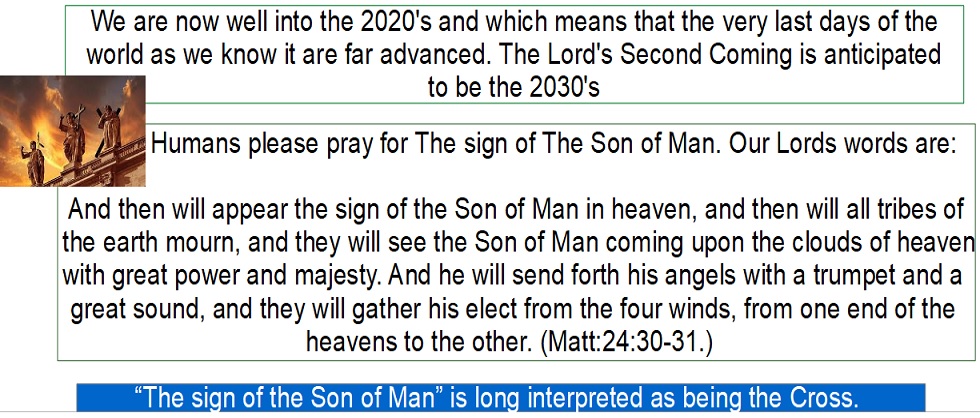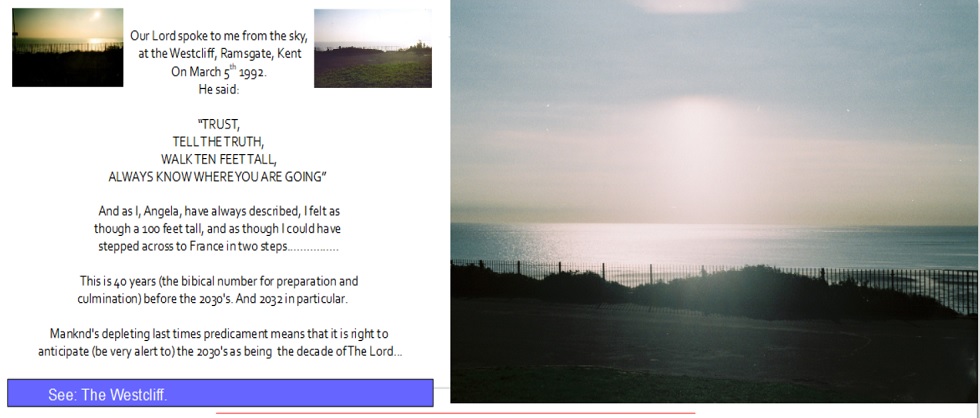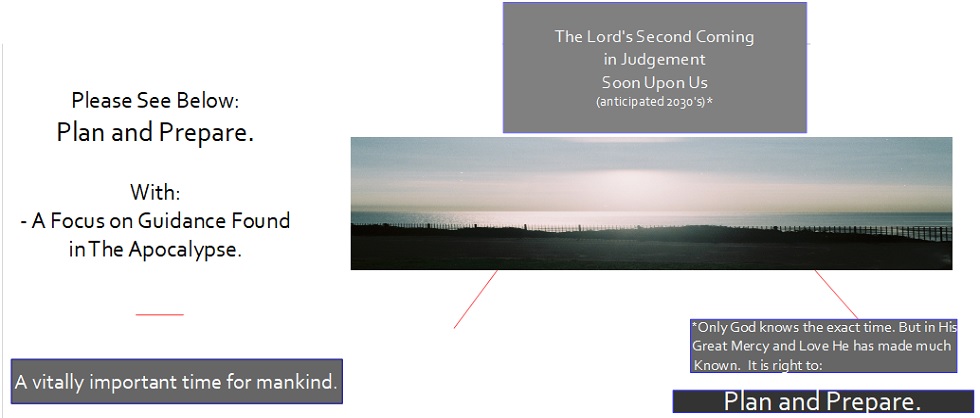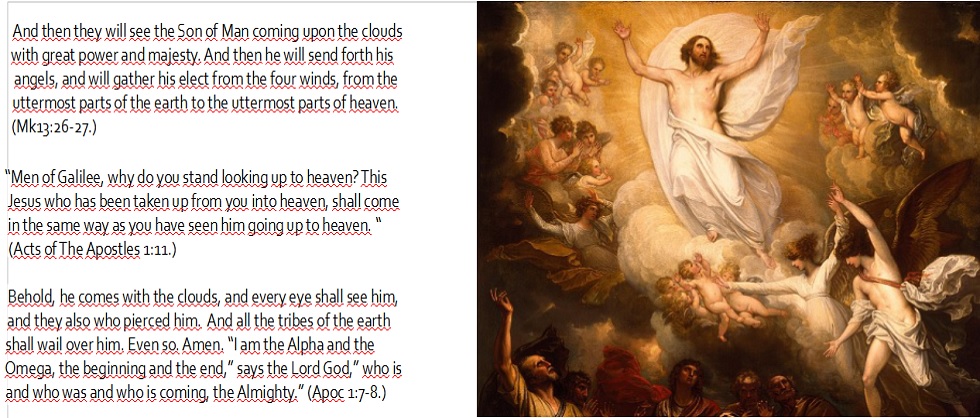Booklet Question (Short version.)
Booklet Question (Short version.)
The question itself (a set question) is unique to these last times of the world as we know it, and is for secularist/non-believers to answer. But the build-up to the question, which is necessary to answer the question, is also itself unique to these very last times of the world as we know it, therefore, it is for both believers and non- believers; to help both believe that these are the very last times of the world as we know it. And, of course, very especially in order to help non-believers to believe in God.
The Question is set in the context of the bewildered man and woman of the early twenty first century, who half hears what is told about God, and half hears what is told by atheists and secularists.
And the question is set in the context of time and place name and place associations. These associations are those which are used by all intelligent species, and very much in the divine context. I have referred to it in the Booklet in the build- up to the Question, and with examples, in the following way:
--------
The Bible reveals to us that names of persons and places can be significant, and that these names can have a significance that becomes apparent in a particular way at a particular time; for example, Our Lord being called “Jesus” meaning “Emmanuel.”
The Archangel Gabriel told Zachary that his son must be called John (John the Baptist) (Lk: 1:13) even though there was no one of that name in Zachary's family (Lk: 1:59-63.) The Book of Micah tells us that the Saviour would be born in Bethlehem of Judea (Mt 2: 5-6. Mich,5:2.) Our Lord Himself named Simon “Peter” meaning “Rock” signifying the solid foundation upon whom He would build His Church “..thou art Peter, and upon this rock I will build my Church, and the gates of hell shall not prevail against it.....”(Mt 16:18-19.)
There can also be name associations in other ways; a person's name can reflect where their ancestors were from, or what they did; that their ancestors were identified with a certain place or trade. Farmer, Fisher, Miller, Cooper, Baker, being some well known examples. It is all about association and, for example, we might wear traditional colours on certain days of the year, and we carry palms on Palm Sunday, in close association with that special day.
Examples of name associations by way of time and place significance can include what is sometimes known as “a play on words” or “anagram.” These can often denote something in particular. And some cannot help but notice that these can be associated with an event in someone's life, or with something they are doing, or have done. For example, if a Mr Don Lonbridge, whilst sailing his boat under London Bridge, rescued an elderly swimmer who had got into trouble whilst trying to swim across the Thames, that would be an example.
All the more intelligent, good and bad, use name associations. The fallen angels; the apostate angels, with their vast retained intelligence, now in evil form, use name identities and time and place identities too, as they would have once done in a good form. And so there can be good and there can be bad name and place associations and with many; good and bad, taking place simultaneously; occurring in relation to the same identity and at the same time.
What has all of this to do with the build up to the question that is going to be asked?
It to help them to believe in God and is set in the context of Medjugorje in the following way:
There is a place in Bosnia and Herzegovina and which is called Medjugorje. This, its name, has long been its name; historical sources record it from at least the sixteenth century. This place is very well known to Catholics. It attracts numerous.
Around thirty million have flocked there over the previous few decades, and more than a million continue to do so annually. It is controversial but almost all Catholics have at least heard of Medjugorje. Why?
It is because of the alleged (and allegedly on-going) apparitions of the Blessed Virgin Mary, and which, allegedly, began on the feast of St John the Baptist, in 1981.
Many dismiss the phenomenon, and agree with the findings of Bishop Pavao Zanic, whose role it was, in the office of local Bishop, to carry out the relevant investigations. He set in place two commissions and took his findings to Rome himself; handing them to the Congregation For The Doctrine of the Faith (CDF) in person in 1986. He followed this up with his well known statement on the matter:
"Propaganda in favor of Medjugorje is being rushed in order to place the Church and the world before a fait accompli. This has been the intention of the defenders of Medjugorje from the beginning. It must be admitted that they have succeeded, because the other side is either working too slowly or remaining silent.....For a short description of the falsehoods about Medjugorje we would need 200 pages." (A statement by Mgr. Pavao Zanic, published in 1980.)
And his 1987 sermon:
"It is said that Our Lady began appearing at Podbro on mount Crnica, but when the police banned going there, she went into homes, on fences, into the fields, into vineyards and tobacco fields, she appeared in the church, on the altar, in the sacristy, in the choir loft, on the roof, on the bell tower, on the roads, on the road to Cerno, in a car, in a bus, on a carriage, in a few places in Mostar, in more places in Sarajevo, in the convents of Zagreb, in Varazdin, in Switzerland, in Italy, again in Podbrdo, on Mt. Krizevac,in the parish, in the parish rectory, etc. Surely not even half the places of the so-called apparitions have been counted, and a sober person who venerates Our Lady, would naturally ask himself: Dear Mother of God, what are they doing to you"? (From a sermon by Bishop Zanic 25th July 1987.)
His successor in office, Bishop Peric, has the same negative findings approach. Nevertheless, the CDF, on receiving Bishop Zanic's report in 1986, relieved him of his remit as local investigating Bishop (the same with his successor) and set in place their own commission and followed by a further commission. The results of which, said to have been made known in 2014, are not entirely clear.
But it has been made known that the alleged apparitions are not approved, but with it also being said that there is a view, held by many of the commissioners, of there being more likelihood of an original (alleged) apparition(s) rather than anything on-going. Some also say that parts of the investigation are still on-going. Pilgrims are still allowed to go there. And whilst also with, of course, that the Blessed Virgin Mary can be honoured in Medjugorje, as She would be honoured anywhere else.
Bishop Peric, in early 2017, reiterated his constant position, stating that: “there is no truth to the alleged apparitions in Medjugorje.” It is the continuing commissions that have, in effect, kept the whole phenomenon high profile and as on-going. Why?
All of this in spite of this: How can it be the Blessed Virgin Mary when, apart from all of the many other reasons, there is what is known as “the false ecumenism of Medjugorje” and which religious pluralism could not ever, ever possibly have come from the Blessed Virgin because, in effect, it amounts to a denial of Her Son as redeemer; and the necessity of His redeeming work. And this is all very serious. There are Catholics unaware of this side of the alleged apparitions.
This is all, of course, different to those who genuinely honour the Blessed Virgin at Medjugorje in the same way as they would honour Her anywhere else. It is very important to honour Her and, as Catholics know, the Blessed Virgin Mary never forgets those who honour Her. She is our glorious Mother and Queen. We thank the Lord for Her.
But now back to our bewildered man or woman of the 21st century. On hearing of all of this, they may, well, just put it all down to a phenomenon and a disagreement amongst Catholics, and not take much notice otherwise. Except that is, for one thing. And it is this which brings us now to the immediate build up to the question.
---------
In the immediate build-up to the question, the Booklet also makes a number of points about Rome, as follows:
---------
References in scripture and prophesy either can be, or are, directly identified with Rome; “the eternal city” “the beloved city” (Apoc 20.) St Malachy's ancient prophesy/vision refers to “the seven hilled city” (Rome.) The Secret of La Salette refers to Rome. Rome is where St.Peter established the Church; the centre is in Rome.
The terrible chastisement of the last times affects the Church severely; it is all a part of the final tribulation. And which reflects scripture; the Apocalypse ch 13 and ch 20 and also St.Paul's prophesy in II Thessalonians II. This is about the time immediately preceding Our Lord's Second Coming. The Church has always taught that She would experience a period of trial in the build up period.
And in the ancient prophesy of St Malachy. St Malachy's seven hilled city is Rome. And so we come back to the significance of Rome. And Rome the city itself is also different to Rome as being synonymous with the Church.
In the very early times of the Church, before Christianity was recognized with consistency by the Roman Empire, Imperial Rome was seen as synonymous with those nations who, in any era, are antagonistic to the Church; to Her role and to Her mission.
But which is, of course, different to the generosity shown to the Church by the Italian aristocracy and landowners who, between the 4th and 7th centuries, gave (gifted) lands; their own source of income, and their children's inheritance, to the Church. One of the most unsung acts of generosity in history and which gave the Church (and mankind) a great chance, in those grace filled times. And this land, the Papal States; the sovereign States of the Church, spread right across central Italy; it protected the Church, and ensured Her independence.
But when, in the mid-late nineteenth century the Church was unable to defend Her States, during Italian unification (and which eventually condensed into Vatican City State) Pope Pius IX sought earnestly that Rome, so associated with the Church, not be the capital of Italy. To no avail. And so there is Rome, the city, and there is Rome, the Eternal city, of the Church. And Our Lord, will Judge all at His Second Coming in Judgement. And with much associated with Rome. Now to the Question.
This Question is for secularists, and for all non-believers. It is not about Rome itself, nor is it about any personal grievance that anyone might have with the Church. As with Rome itself, and as with all cities and nations, it is Our Lord who will Judge.
And many prayers for ourselves and for others should be said in anticipation of that time; the day when all will kneel humbly before Him, He who is the King of kings, the Lord of Lords, and the Ruler of rulers. And on that day much sparse land there will be, for Our Lord will rid us of the terrible final chastisement; the apostate angels amongst us. And, in that day, very many will wonder where those who they have long known have gone. And find those who they should have known before. The day when all will understand that the first goal in life is unto salvation. And on that Day be pleased to know the Song of Moses (Deut.31:30-32:44.) And to be in White Robes, and to be singing the Song of the Lamb. (Apoc. 15:3) (19:7-9.)
The Question for secularists, and for all non-believers of the last times is this:
Please explain as to how, in this era in which so much points to Our Lord's Second Coming in Judgement being now imminent, and with so much associated with Rome, in this build-up period there has come to the fore, a now prominent, high profile, ancient town, whose name association identity is: Medjugorje (Jjudgerome) ?
--------
And the Question is indeed there for non-believers to answer. Perhaps scientifically! Their explanation as to why the name, why so prominent now, and when named now so long ago.
And to help believers to believe that these really are the very last times of the world as we know it. And so what of Medjugorje itself? Well it does have a very, very notable significance for preparations for the Lord! Which must, of course, be in the right way. And remember it was named many centuries ago. It is being associated with so specifically now, because these are the very last times of the world as we know it!
Extracts From: A Catholic Question: To Secularists, and To All Non-believers Of The Last Times. By Angela Anne Mary St John (Angela Margaret Mary Searles.)© Apostle of The Lord.
The Full version of the Booklet can be read here:
A Question ( a set Question) and unique to these very last times of the world that we are now in: (Please do read the Booklet, as is normal...







